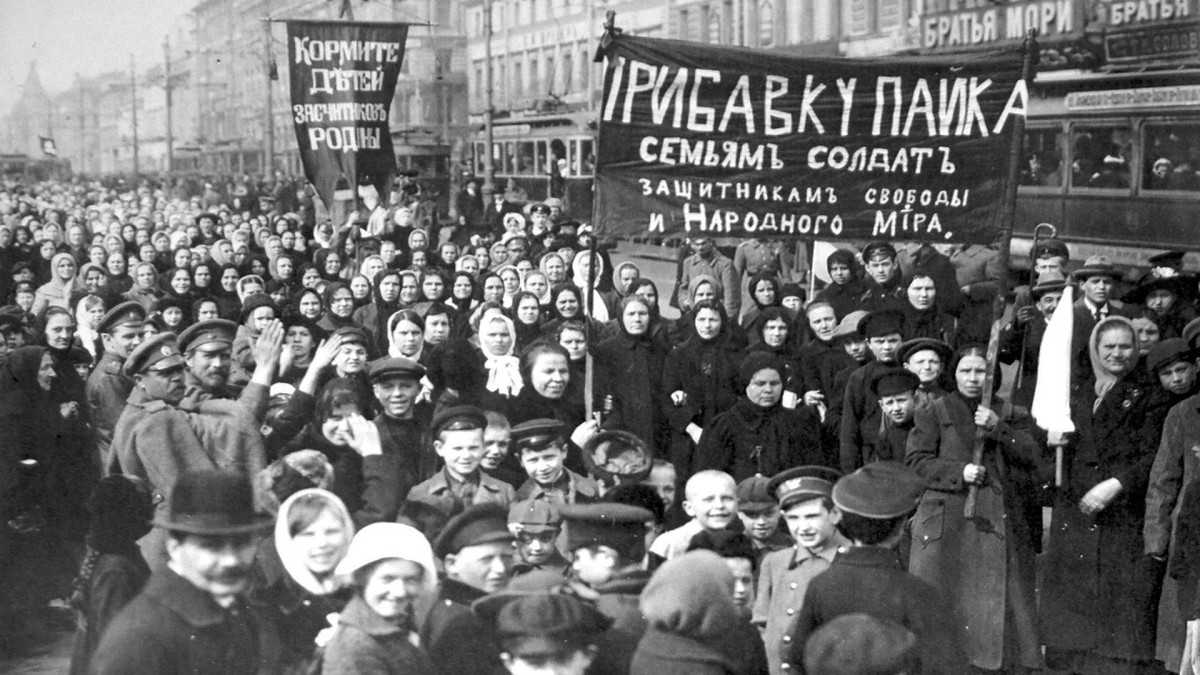By February only ten days’ supply of flour was left in the capital, and the regional commander set up a rationing system. Long lines, closed shops, and the prospect of starvation led to disorder.
In the Duma “unfit ministers” were attacked. The left-wing deputies turned to the secret organizations, which had already been working up public opinion against the government’s dismissal of thousands of factory workers after a strike. The strikers demonstrated in the streets, and thousands of other workers, led by the wives of the workers, massed in a march that was broken up by mounted police.
By the third day the Bolsheviks had taken charge of the continuing strikes and parades. The czar’s secret police, the Okhrana, conducted mass arrests. But the soldiers were now refusing orders to stop the workers as they sought to march across the River Neva from the workers’ quarter to the palaces, and on March 10 (February 27 in the old Russian calendar) many soldiers handed their weapons over to the crowd. The insurgents captured the arsenal with forty thousand rifles, and Petrograd (as St. Petersburg was now called) was in their hands.
The Revolution of February and March 1917, a product of despair and high emotion, remained virtually leaderless and without a program, since those who had been planning revolution were not yet fully prepared. The main Bolshevik leaders were still abroad or in exile, and the radical agrarian group (the Social Revolutionaries, SR) and the more philosophical Marxists (the Social Democrats, SD) were also caught by surprise. Nonetheless, by March the Romanov dynasty, which had ruled since 1613, was without hope.
A determining factor in the overthrow of the czar was the disintegrating loyalty of the garrison of Petrograd. When the czar ordered his troops to fire on the rioters, only a few obeyed, and in revulsion against the order, the troops joined the dissidents and began to hunt the police. On March 12 the Progressive Bloc in the Duma formed a provisional government to keep order until there could be a constituent assembly. By March 14, when the czar finally decided to appoint a responsible ministry, it was too late. On March 15 he abdicated in favor of his younger brother, Michael, and on March 16 Michael refused the throne.
Before that, on March 12, leftists, including many released from prison by the mobs, formed a Soviet of workers and soldiers, modeled on the 1905 Soviet. Its “Army Order No. 1,” setting up a committee of soldiers within every unit of the army to control weapons, dealt a blow to military discipline and organization. The Soviet created a food-supply commission and published newspapers; its fifteen-man executive committee of SRs and
Mensheviks became the policy makers of the revolution.
The Soviet located its headquarters in the same building as the Duma and was soon in conflict with it. The Duma wanted to get its provisional government functioning quickly, to restore public order, and to carry on the war with efficiency for the honor of Russia. Some Duma members were monarchists; some wanted to continue the war and receive Constantinople as a reward; most felt the question of citizens’ rights was secondary to these more pressing matters. The Soviet, on the other hand, knew that the great mass of Russian people did not care about Constantinople and wanted an immediate peace, as well as land and food.
The Marxists among the Soviet leaders—mainly Mensheviks—believed in the necessity of a preliminary bourgeois revolution, and they did not yet regard the Soviet itself as an organ of power. Therefore, though they would not participate in the provisional government, they offered it their limited support. Despite their widely differing political and economic aims, both the Duma and the Soviet agreed to grant political liberties immediately and to summon an assembly to establish the future form of government and give Russia a constitution.
The provisional government was composed mainly of Kadets (Constitutional Democrats) and other moderates and was headed by the liberal prince Georgi Lvov (1861-1925). It also included one member of the Soviet, the moderate SR Alexander Kerensky (1881-1970), minister of justice, who was a member of the Duma.

